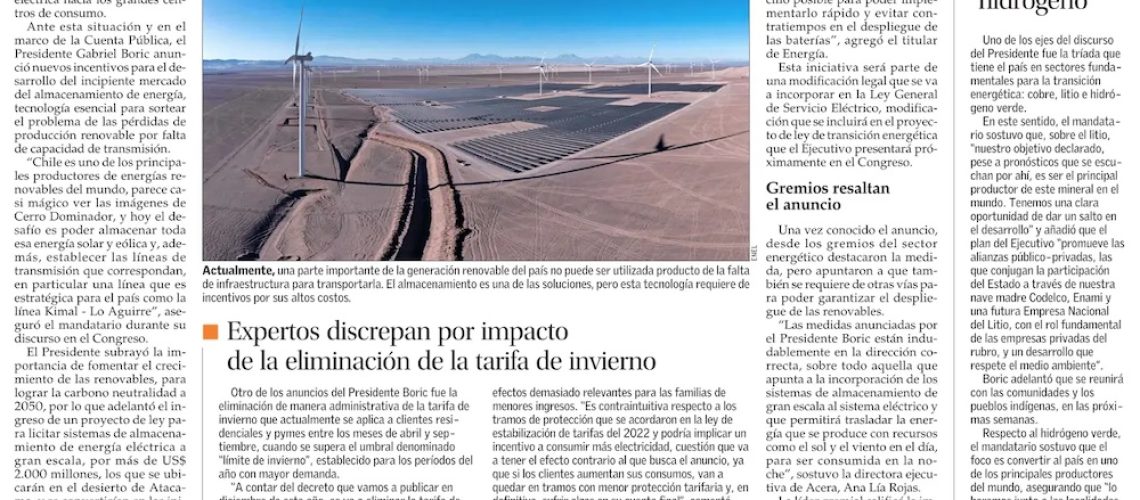President Boric presented in his annual account a bidding system similar to the one carried out in the electric transmission segment. The Executive aims for these works to come into operation as of 2026.
One of the main obstacles facing the development of the renewable energy sector is the lack of infrastructure to transport electricity production to large consumption centers. Faced with this situation and within the framework of the Public Account, President Gabriel Boric announced new incentives for the development of the incipient energy storage market, essential technology to overcome the problem of renewable production losses due to lack of transmission capacity.
“Chile is one of the main producers of renewable energy in the world, it seems almost magicalsee the images of Cerro Dominador, and today the challenge is to be able to store all that solar and wind energy and, in addition, establish the corresponding transmission lines, particularly a line that is strategic for the country such as the Kimal – Lo Aguirre line”, assured the president during his speech in Congress.
The President stressed the importance of promoting the growth of renewables, to achieve carbon neutrality by 2050, for which he advanced the entry of a bill to tender large-scale electrical energy storage systems, for more than US$ 2,000 million, which will be located in the Atacama desert, and would become the largest initiatives of this type on the continent.
Subsequently, the Minister of Energy, Diego Pardow, detailed the announcement explaining that this system would work under a similar logic to the development of electrical transmission works, operated by the National Electrical Coordinator. The scheme devised by the Government points to a storage of 2 GW for 4 hours or 1 GW for 8 hours, among other alternatives that are being considered.
“This stems from the observation that storage systems are being deployed very slowly, mainly due to the endogeneity of revenue associated with price arbitrage. This makes these storage systems difficult to finance with external financing, with project finance or with credit, therefore, it often happens that they are financed with capital contributions”, commented Pardow.
In this sense, the Government’s plan considers a tender that comes to ensure the income of the storage system, remunerating them with a transmission charge and, in turn, generating a rate discount with all the income obtained by price arbitration, payments for power, among other income.
“The idea of this storage system is that it be tendered during the year 2024 and start operating in the year 2026. The details of the bidding instrument have yet to be defined, but the idea is that it be as simple as possible to be able to implement it quickly and avoid setbacks in the deployment of the batteries”, added the Minister of Energy.
This initiative will be part of a legal modification that will be incorporated into the General Electric Service Law, a modification that will be included in the energy transition bill that the Executive will soon present in Congress.
Guilds highlight the ad
Once the announcement was made known, unions in the energy sector highlighted the measure, but pointed out that other ways are also required to guarantee the deployment of renewables.
“The measures announced by President Boric are undoubtedly in the right direction, especially the one that points to the incorporation of large-scale storage systems into the electrical system and that will allow the transfer of energy produced with resources such as the sun and the wind during the day, to be consumed at night”, said the executive director of Acera, Ana Lía Rojas.
The union leader described the implementation of this plan as “ambitious”, due to the narrow deadlines considered, for which she insisted “on the value of urgent measures with short-term effects.”
From the Association of Concentrated Solar Power (ASCP), after the Public Account, they assured that “there is no doubt that it is the opportunity for CSPs”. The union’s president, Cristián Sepúlveda, recalled that to decarbonize the matrix, not only clean energy generation is required, but also the stability and flexibility offered by this technology. “We are happy that President Gabriel Boric is taking on the challenge we have as a country of being able to store the renewable energy we produce,” Sepúlveda said.

